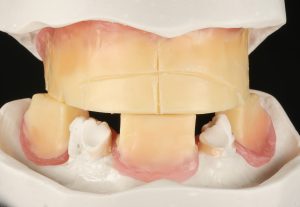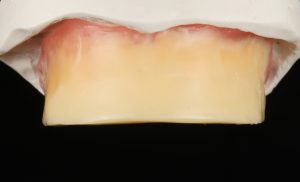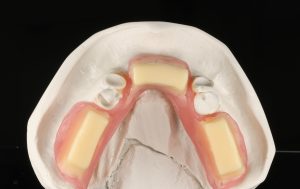The Bite Block Blog

In removable dentistry, we are facing multiple challenges. One of the biggest challenges is that we are supposed to set teeth in a “big black hole”, like a blank canvas. While this sounds like an impossible feat, we know that we can utilize tools to help us to establish a starting point. When we look at an edentulous patient, in many cases, the vertical dimension of occlusion (VDO) and aesthetics are lost or a focus for improvement. So, we must start by putting landmarks in place. What is the solution for establishing a correct VDO or to set up the correct anterior tooth position and ideal buccal corridor? The ideal tool is the bite registration or what we call it in dental slang, the “bite block.”
The concept of the bite block, which is a fundamental component in dentistry, helps us to establish the patient’s VDO. It identifies incisal edge, midline position, smile line, and plane of occlusion. The bite block consists of a base plate and a wax rim. The base plate is usually made of acrylic or a light cure resin-based material and the wax rim is soft so there can be markings made directly to it. The wax rim gives you tooth position, not only from the vertical standpoint but also from the buccal corridor and facial extension. To achieve this information, the clinician can cut, add, and/or carve the wax to its final size and shape. The bite block is used in edentulous treatment workflows and has to be properly retentive and fitting. For implant retained restoration, we can utilize retentive attachments like locator like clips or we can screw retain the bite block to make sure it has a stable fit which can be re produced on the master cast in the laboratory, so we can articulate the master cast with the opposing model. For non-implant cases, we must make sure to utilize certain undercuts at the ridges and/or extend the bite block similar like a denture, so it has the “suction” effect, therefore incorporating a post damn is a good feature. With these added features the bite block should be stable enough to take the occlusal record. In some cases, we have to utilize denture adhesive to be able to achieve a stable fit and hold of the bite block in the mouth. That is why the bite block the gold-standard. The bite block average measurement are 22 mm for the maxillary arch and 18 mm for the mandibular arch




When the bite block fits perfectly and all adjustments are made, the clinician needs to take photos so we can see what the patient looks like. Important photos are: Full face retracted, full face smile, profile in rest and profile in smile. These photos are a huge help and are fundamental for the technician to understand the case, since we are usually not in the same room as the clinician with the patient. The wax rim that we utilize elevates the patient experience because it is vanilla-scented and beige-colored so it smells great and resembles teeth. This allows patients to already imagine where the teeth are going to be.
In August, Zahntechnique is releasing our Removable Webinar Series of six modules and we are opening up our series with the fundamentals and basics of removable dentistry, which will include the bite block and its use. Don’t forget to register by clicking here.